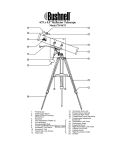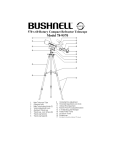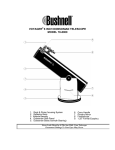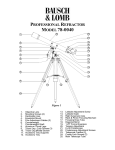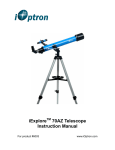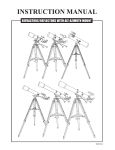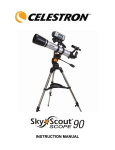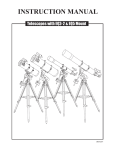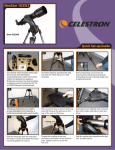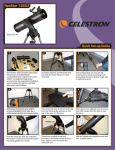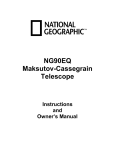Download Bushnell 78-9500 User's Manual
Transcript
Telescope Instruction Manual 78-9500 60mm RefraCtor Lit. #: 91-0264/08-01 Never Look Directly At The Sun With Your Telescope Permanent Damage To Your Eyes May Occur 2. WHERE DO I START? Your Bushnell telescope can bring the wonders of the universe to your eyes. While this manual is intended to assist you in the set-up and basic use of this instrument, it does not cover everything you might like to know about astronomy. Although Northstar will give a respectable tour of the night sky, it is recommended you obtain a very simple star chart and a flashlight with a red bulb or red cellophane over the end. For objects other than stars and constellations, a basic guide to astronomy is a must. Some recommended sources appear on our website at www.bushnell.com. Also on our website will be current events in the sky for suggested viewing. But, some of the standbys that you can see are: The Moon—A wonderful view of our lunar neighbor can be enjoyed with any magnification. Try viewing at different phases of the moon. Lunar highlands, lunar maria (lowlands called "seas" for their dark coloration), craters, ridges and mountains will astound you. Saturn—Even at the lowest power you should be able to see Saturn’s rings and moons. This is one of the most satisfying objects in the sky to see simply because it looks like it does in pictures. Imagine seeing what you’ve seen in textbooks or NASA images from your backyard! Jupiter—The largest planet in our solar system is spectacular. Most noted features are its dark stripes or bands both above and below its equator. These are the north and south equatorial belts. Also interesting are Jupiter’s four major moons. Pay close attention to their positions from night to night. They appear to be lined up on either side of Jupiter. Mars—The Great Red Planet appears as a reddish-orange disk. Look at different times of the year and try to catch a glimpse of the white polar ice caps. Venus—Just like the moon, Venus changes phases from month to month. At times Venus appears brilliantly in the night sky, just as if you were looking at a distant crescent moon. Nebulae—The Great Orion Nebula is a very well known night sky object. This and many others are brought to you by this telescope. Star Clusters—View millions of stars densely packed in a cluster that resembles a ball. Galaxies—One of the greatest and most interesting galaxies is our neighbor, the Andromeda Galaxy. Enjoy this and many others. 3. Parts Diagrams 78-9500 60mm Refractor 4. 3. 1. 2. 5. 13. 12. 9. 10. 11. 6. 7. 8. Telescope Parts Diagram 1. Red Dot Wide Field Finderscope 8. Accessory Tray 2. Eyepiece 9. Rack and Pinion Focusing Mechanism 3. Telescope Main Tube 10. Declination Lock Knob 4. 60mm Objective Lens 11. Counterweight Shaft 5. Latitude Lock Knob 12. Counterweight 6. Tripod Leg 13. Fine Adjustment Cables 7. Accessory Tray Braces 4. QUICK ASSEMBLY DIAGRAM 78-9500 60mm RefRactor Step 2 Step 1 1. Spread tripod legs and attach accessory tray. 2. Attach telescope tube, finderscope, counterweight and fine adjustment cables to pre-assembled Equatorial Mount with pre-attached tripod legs. PARTS LIST • Adjustable Aluminum Tripod Assembly (Three Legs) • Accessory Tray • Refractor Telescope Assembly • Red Dot Wide Field Finderscope • 20mm, 12mm, 4mm Eyepieces • Erect Image Eyepiece (For Land Use) • Barlow Lens • Equatorial Mount 5. DETAILED ASSEMBLY Remove all components from the carton and identify all components. READ THROUGH ASSEMBLY INSTRUCTION BEFORE YOU ASSEMBLE YOUR TELESCOPE. Attach Accessory Tray and Telescope 1. Fold down the accessory tray braces and place the Accessory Tray on top of braces. Attach Accessory Tray with included three small accessory tray bolts and nuts. 2. Locate the pre-assembled Tripod and Equatorial Mount. Remove attachment bolts at top of Equatorial Mount. Attach Telescope Main Tube to the top of the Equatorial Mount. Secure in place by reinserting bolts through Equatorial Mount into base plate. Attach Fine Adjustment Cables, Counterweight, and Finderscope 6. 1. Locate the Fine Adjustment Cables. Screw the silver collars, located at the end of the Fine Adjustment Cables, to the corresponding silver posts found on the Equatorial Mount. 2. Locate the Counterweight and Counterweight Shaft. Loosen the thumb screw located on the Counterweight and slide the Counterweight onto the Counterweight Shaft, and tighten thumb screw to secure the Counterweight. Thread the Counterweight Shaft into the hole located directly below the Declination Lock Knob. Make sure that the shaft is securely locked into mount. 3. Locate the Finderscope with pre-assembled Finderscope Mount. Remove the two nuts located near the front of the telescope (closet to the eyepiece) and place the Finderscope and Finderscope Mount over the exposed screws. Replace the nuts, and securely tighten the Finderscope and Finderscope Mount in place. 4. Adjust tripod leg height to suit by opening tripod leg lock and extending tripod legs to desired height. TightenTripod Leg Lock when complete. 5. Remove objective dust cover ensuring that the entire diameter of the telescope tube is exposed. 6. Insert Eyepiece into Diagonal Mirror then both into the focusing tube to begin viewing. HOW TO USE YOUR NEW TELESCOPE Selecting an Eyepiece 1. You should always start viewing with the lowest power eyepiece, which in this case is the 20 mm lens. Note: the base power of each eyepiece is determined by the focal length of the telescope objective lens. A formula can be used to determine the power of each eyepiece: telescope OBJECTIVE lens focal length divided by EYEPIECE focal length = MAGNIFICATION (e.g. Using the 20 mm lens, a sample calculation would look like this: 700 mm / 20mm = 35x or 35 power. Telescope models will vary in focal length). 2. Included with this telescope is a Barlow lens. Barlow lenses are used to double or triple the power of your telescope. Place your Barlow between the focusing tube and the eyepiece. Using the example above, your 3x Barlow lens would give you a total power of 105x or 135 power. (35 x 3 = 105x or 105 power). The magnification calculation would look like this: 700 mm/ 20mm =35 power. 35 power x 3 = 105 power. Focusing Telescope 1. After selecting the desired eyepiece, aim main telescope tube at a land-based target at least 200 yards away (e.g. a telephone pole or building). 2. Fully extend focusing tube by turning Rack and Pinion Focusing Mechanism. 3. While looking through selected eyepiece (in this case the 20 mm), slowly retract focusing tube by turning Rack and Pinion Focusing Mechanism until object comes into focus. Aligning Finderscope 1. Look through Main Telescope Tube and establish a well-defined target. (see Focusing Telescope section) 2. Looking through Wide Field Finderscope, alternate tightening each Finderscope Adjustment Screw until the red dot of Wide Field Finderscope are precisely centered on the same object already centered in Main Telescope Tube's field of view. 3. Now, objects located first with the Wide Field Finderscope will be centered in the field of view of the main telescope. Never Look Directly At The Sun With Your Telescope Permanent Damage To Your Eyes May Occur 7. HOW TO USE YOUR NEW TELESCOPE (CONTINUED) Understanding the Equatorial Mount The Equatorial Mount is designed to move in any direction. It can be set to allow manual controls to track the movements of celestial bodies across the sky. This is referred to as diurnal movement: movement of celestial bodies in the direction opposite to that of the earth’s rotation and around the earth’s axis. By aligning the telescope’s polar axis at celestial North, you will place the telescope in parallel with the earth’s axis and thus be able to locate stars in the sky based on star atlas information. 1. Set up the telescope at night. Loosen the Declination Lock Knob and rotate the telescope around the declination axis until the arrow on the declination scale points to 90 degrees. Tighten the Declination Lock Knob. 2. Look up the latitude of your area in any geographical atlas. Loosen the Latitude Lock Knob and set the latitude scale to the correct latitude for your area. Aim the Finderscope at Polaris. You will probably notice that Polaris is not dead center in the Finderscope’s field of view. This is probably because your telescope is not absolutely level with the ground. Loosen the Horizontal Axis Lock Knob again and turn the telescope so that it is directly aimed at Polaris. Tighten both the Horizontal Axis Lock Knob and Latitude Lock Knob. Polaris is 1 degree from the North celestial pole. Therefore, the sighting of stars will have to be slightly adjusted as you locate them in the heavens. LATITUDE N N EARTH’S AXIS (CELESTIAL AXIS) POLAR AXIS S S POLAR AXIS & EARTH’S AXIS 8. M ENJOYING YOUR NEW TELESCOPE 1. First determine your targeted object. Any bright object in the night sky is a good starting point. One of the favorite starting points in astronomy is the moon. This is an object sure to please any budding astronomer or experienced veteran. When you have developed proficiency at this level, other objects become good targets. Saturn, Mars, Jupiter, and Venus are good second steps to take. 2. The first thing you need to do after assembling the telescope as planned is center the desired object in the finderscope’s crosshairs. Provided you did a reasonable job aligning the finderscope, a quick look through the main telescope tube at low power should reveal the same image. With the lowest power eyepiece (the one with the largest number printed on it) you should be able to focus the same image that you saw through the finderscope. Avoid the temptation to move directly to the highest power. The low power eyepiece will give you a wider field of view, and brighter image—thus making it very easy to find your target object. At this point with a focused image in both scopes, you’ve passed the first obstacle. If you don’t see an image after attempting to focus it in, you might consider aligning your finderscope again. Once you pass this step, you will enjoy the time spent ensuring a good alignment. Every object you center in the finderscope will be easily found in the main telescope tube, which is important for continuing your exploration of the night sky. 3. The low power eyepieces are perfect for viewing the full moon, planets, star clusters, nebulae, and even constellations. These should build your foundation. However, for more detail, try bumping up in magnification to higher power eyepieces on some of these objects. During calm and crisp nights, the light/dark separation line on the moon (called the "Terminator") is marvelous at high power. You can see mountains, ridges and craters jump out at you due to the highlights. Similarly, you can move up to higher magnifications on the planets and nebulae. Star clusters and individual stars are best viewed through the low power no matter what. 4. The recurring astronomical theater we call the night sky is an ever-changing billboard. In other words, the same movie doesn’t play all the time. Rather, the positions of the stars change not only hourly as they seem to rise and set, but also throughout the year. As the earth orbits the sun our perspective on the stars changes on a yearly cycle about that orbit. The reason the sky seems to move daily just as the sun and the moon "move" across our sky is that the earth is rotating about its axis. As a result you may notice that after a few minutes or a few seconds depending on what power you are viewing at, the objects in your telescope will move. At higher magnifications especially, you will notice that the moon or Jupiter will "race" right out of the field of view. To compensate, just move your telescope to "track" it in the necessary path. 9. M HELPFUL HINTS 1. Your telescope is a very sensitive instrument. For best results and fewer vibrations set your telescope up on a level location on the ground rather than your concrete driveway or your wooden deck. This will provide a more stable foundation for viewing, especially if you’ve drawn a crowd with your new telescope. 2. If possible view from a location that has relatively few lights. This will allow you to see much fainter objects. You’d be surprised how much more you’ll see from your local lake or park when compared to a backyard in the city. 3. Using your telescope out a window is NEVER recommended. 4. View objects that are high in the sky if possible. Waiting until the object rises well above the horizon will provide a brighter and crisper image. Objects on the horizon are viewed through several layers of earth’s atmosphere. Ever wonder why the moon appears orange as it sets on the horizon? It’s because you are looking through a considerable more amount of atmosphere than you would directly overhead. (Note: If objects high in the sky are distorted or wavy, you are probably viewing on a very humid night.) During nights of unstable atmosphere, viewing through a telescope can be frustrating if not impossible. Astronomers refer to crisp, clear nights as nights of "good seeing." WARRANTY / REPAIR Your Bushnell® telescope is warranted to be free of defects in materials and workmanship for the lifetime of the original owner. The Lifetime Limited Warranty is an expression of our confidence in the materials and mechanical workmanship of our products and is your assurance of a lifetime of dependable service. If your telescope contains electrical components the electronic components are warranted to be free of defects in materials and workmanship for one year after date of purchase. In the event of a defect under this warranty, we will, at our option, repair or replace the product, provided that you return the product postage prepaid. This warranty does not cover damages caused by misuse or improper handling, installation or maintenance of the product. Any return made under this warranty must be accompanied by the items listed below: 1) 2) 3) 4) A check in the amount of $15.00 to cover the cost of handling Name and address for product return An explanation of the defect Product should be well packed in a sturdy outside shipping carton to prevent damage in transit and return postage prepaid to the address listed below: IN U.S.A. Send To: Bushnell Performance Optics 8500 Marshall Drive Lenexa, Kansas 66214 IN CANADA Send To: Bushnell Performance Optics 25A East Pearce Street, Unit 1 Richmond Hill, Ontario L4B 2M9 For products purchased outside the United States and Canada please contact your local dealer for applicable warranty information. This warranty gives you specific legal rights. You may have other rights which vary from country to country. Copyright 2001 Bushnell Performance Optics 10. M NOTES 11.












